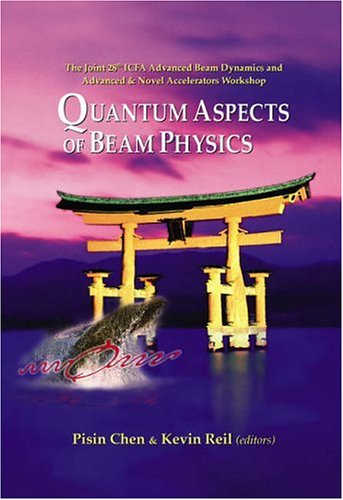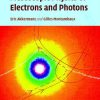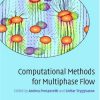(EBOOK PDF) Quantum Aspects of Beam Physics 1st edition by Pisin Chen, Kevin Reil 9789812702333 9812702334 full chapters
$50.00 Original price was: $50.00.$35.00Current price is: $35.00.
Quantum Aspects of Beam Physics 1st edition by Pisin Chen, Kevin Reil – Ebook PDF Instant Download/Delivery: 9789812702333 ,9812702334
Full download Quantum Aspects of Beam Physics 1st edition after payment
Product details:
• ISBN 10:9812702334
• ISBN 13:9789812702333
• Author:Pisin Chen, Kevin Reil
QUANTUM ASPECTS OF BEAM PHYSICS 2003
This proceedings volume of the 3rd International Workshop on Quantum Aspects of Beam Physics, presents the latest advances in beam dynamics. The frontiers of beam research point to increasingly high energy, greater brightness and lower emittance beams with ever-increasing particle species. These demands have triggered a rapidly growing number of beam phenomena that involve quantum effects.In addition to the more established topics, this volume covers topics on high energy-density particle and photon beams for laboratory astrophysics investigations, as well as the application of beam physics expertise to astrophysics studies. Other exciting new topics are the physics of ultra-cold or condensed beams, such as the “crystalline beams” and the Bose-Einstein condensate “atom lasers”.This book will be a valuable source of reference to readers interested in the interdisciplinary frontiers of “quantum beam physics” that involve beam physics, particle physics, laser science, astrophysics, condensed matter physics, nuclear and atomic physics.The proceedings have been selected for coverage in:• Index to Scientific & Technical Proceedings® (ISTP® / ISI Proceedings)• Index to Scientific & Technical Proceedings (ISTP CDROM version / ISI Proceedings)• CC Proceedings — Engineering & Physical Sciences
Quantum Aspects of Beam Physics 1st Table of contents:
CONTENTS
Preface P. Chen
I. Quantum Fluctuations and Methodologies in Beam Physics
On Coherent Radiation in Electron-Positron Colliders V. N. Baier, V. M. Katkov
1. Introduction
1.1. General formulas
2. Photon Emission
3. Pair Creation
References
Quantum Mechanics of Dirac Particle Beam Transport Through Optical Elements with Straight and Curved
1. Introduction
2. Quantum Beam Optics of Particles: An Outline
3. Quantum Beam Optics of Dirac Particles: Optical Elements with Straight Axes
4. Quantum Beam Optics of Dirac Particles: Optical Elements with Curved Axes
5. Concluding Remarks
Acknowledgments
References
Pattern Formation in Wigner-Like Equations via Multiresolution A. N. Fedorava, M. G. Zeitlin
1. Wigner-like Equations
2. Variational Multiscale Representation
Acknowledgements
References
The Halo Formation in Charged Particle Beams: A Stochastic-Hydrodynamic Approach N. C. Petroni, S. D
1. Introduction
2. Self consistent equations
Acknowledgments
References
II. Photon-Electron Interaction in Beam Production, Cooling and Monitoring
Compton Scattering and its Applications: The Pleiades Femtosecond X-Ray Source at LLNL F. V. Hartema
1. Introduction
2. Electron Beam Design
2.1. Experimental layout
2.2. Electron beam production
3. Calculation of X-ray Production
4. Electron Beam Characterization
5. X-Ray Production
6. Conclusions
References
Infrared Synchrotron Radiation in Accelerator Experiments A. A. Maltsev
1. Introduction
2. Infrared Sources
3. Methods
3.1. Number of charge-partilens
3.2. Geometrical parameters
3.3. Angular divergence
4. Experimental Apparatus
5. Conclusion
References
Infrared Coordinate Detector for the Measurement of Angular Divergence in Synchrotron Radiation A. A
1. Introduction
2. Experimental technique
3. Experimental result
4. Summary
References
Study of Laser Compton Scattering in a Plasma Channel T. Kumita, Y. Kamiya, I. Ben-Zvi, K. Kusche, I
1. Introduction
2. Plasma Channeling of the CO2 laser
3. Compton scattering experiment in the Plasma Channel
Acknowledgments
References
Irreversible Process in a Photon Gas N. L. Tsintsadze, K. Nishikawa, Y. Kishimoto, N. A. Papuashvili
1. Introduction
2. Relaxation time of a photon gas
3. Summary and Discussions
Acknowledgments
References
Production of a Short-Bunch Polarized Positron Beam and Design of a Positron Polarimeter M. Fukuda,
1. Introduction
2. Transmission method
3. Gamma-ray polarimetry
4. Design of positron polarinieter
5. Conclusion
Acknowledgments
References
X-Ray Spectrometer for Observation of Nonlinear Compton Scattering Y. Kamiya, T. Kumita, D. P. Siddo
1. Introduction
2. Experimental Setup
3. Simulation Study
4. Test Experiment of the Spectrometer
5. Conclusion
Acknowledgment
References
Application of Optical Diffraction Radiation to a Non-Invasive Low-Emittance High-Brightness Beam Di
1. Introduction
2. Beam size effect in optical diffraction radiation
3. Applicability of DR to non-invasive electron beam diagnostics
4. Conclusion
References
Generation of High Quality Electron Beam by Laser-Plasma Interaction H. Kotaki, S. Masuda, M. Kando,
1. Introduction
2. Optical injection of two laser pulses
3. Conclusions
References
Polarization of Final Photons in Nonlinear Compton Scattering for Linearly Polarized Laser L. Donggu
1. Introduction
2. Kinematics of Nonlinear Compton Scattering
3. Transition Probability
4. Final Photon Polarization
5. Conclusions
References
Is it Possible to Obtain Polarized Positrons During Multiple Compton Backscattering Process? A. P. P
References
ID PIC Simulation of Plasma Cathode S. Masuda, M. Kando, H. Kotaki, S. Kondo, S. Kanazawa, T. Honma,
1. Introduction
2. ID PIC Simulation Model
3. Simulation Results
4. Summary
References
III. Beam Phenomena under Strong Fields
Boiling the Vacuum with an X-Ray Free Electron Laser A. Ringwald
1. Introduction
2. X-Ray Free Electron Lasers
3. Semi-classical Rate Estimates
4. Quantum Kinetic Studies
5. Conclusions
References
Unruh Effect as Particular Frenet-Serret Vacuum Radiation and Detection Proposals H. C. Rosu
1. Frenet-Serret Worldlines and Vacuum Radiation Patterns
1.1. The Six Stationary Scalar Frenet-Serret Radiation Spectra
1.2. Conclusions from the Stationary Scalar Cases
2. Detection Proposals
2.1. Unruh Effect in Storage Rings
2.2. Unruh Effect and the Physics of Traps
2.3. Unruh Effect and Nonadiabatic Casimir Effect
2.4. Unruh Effect and Channeling
2.5. Unruh Radiation and Ultraintense Lasers
2.6. Unruh Radiation in Quantum Optics (Moderate a could Work)
3. Conclusion
Acknowledgements
References
Quantum Excitation-Free Radiation Emission Including Multiple Scattering U. I. Uggerhoj
1. Introduction
2. Channeling, multiple scattering and dechanneling
3. Quantum excitation-free radiation emission including multiple scattering
4. Results
5. Conclusions
Acknowledgments
References
Flying Mirrors: Relativistic Plasma Wake Caustic Light Intensification T. Zh. Esirkepov, S. V. Bulan
1. Introduction
2. Mirrors in the plasma wake wave
3. Three-dimensional particle-in-cell simulation
4. Conclusion
Acknowledgments
References
Quantum Theory of Laser-Beam Compton Interaction and Stimulated Electron-Positron Annihilation in a
1. Introduction
2. Quantum Kinetics of the Laser Cooling of Relativistic Electron Beam
3. Quantum Limit in the X-ray FEL Theory
4. Stimulated Coherent Annihilation in the Strong Field
References
Interaction of Charged Particles with Ultra Strong Electromagnetic Waves in the Radiation Dominant R
1. Introduction
2. Electron interaction with a circularly polarized electromagnetic wave in a plasma in the radiatio
3. Scattering of the laser light on small clusters and the interaction of a super-intense laser puls
3.1. The laser-cluster interaction
3.2. High efficiency ion acceleration during the laser-foil interaction
4. Intensification of the electromagnetic radiation during its interaction with the “flying mirror”
References
Electron-Positron Pair-Beam Production and Acceleration in Ultra-Strong Laser-Plasma Interactions K.
1. Introduction
2. Pair production processes in laser fields
2.1. Multiphoton pair creation in a Coulomb field
2.2. Pair creation by relativistic electrons
2.3. Pair creation by an incident non-laser photon
3. Electron acceleration in plasmas
3.1. Basic equations for particle acceleration in plasma
3.2. Production of a high energy ultrashort intense electron beam in plasmas
4. Pair-beam production yield in plasmas
4.1. A trident process in the nuclear field
4.2. A trident process in the counter-propagating laser field in plasma
5. Relativistic ponderomotive acceleration and focusing of a pair beam
5.1. A focused beam size limited by the space charge force
5.2. A focused beam size limited by the thermal emittance
5.3. Application to a high energy electron-positron collider
6. Conclusions
References
Quantum Aspects of Super-Strong Field Interactions H. Takahashi
1. Introduction
2. Non-linear of A2 term in the Hamitonian
3. Many modes interacting system (analysis by Exponential Hilbert space)
4. Conclusion.
Acknowledgments
References
IV. High Energy and Laboratory Astrophysics
A Crystal-Based Matter Wave Interferometric Gravitational-Wave Observatory R. Y. Chiao, A. D. Spelio
1. Introduction
2. Brief Review of Atom Interferometry
2.1. Supersonic Sources and 2D Optical Molasses Collimation
2.2. Atomic Beam Optics
3. LIGO, LISA, and the Detection of GWs
4. The .Matter-wave Jnterferometric Gravitational-wave Observatory (MIGO)
4.1. The Vertical MIGO Configuration
4.2. MIGO and LIGO: The Underlying Physics
4.3. Phase Shift Calculation
4.4. Potential Sensitivity
5. Conclusion
Acknowledgements
References
Gravitational-Wave Induced Effects in Storage Rings Beam Dynamics D. Dong, C.-G. Huang
Acknowledgements
References
Cosmological Final Focus Systems J. Irwin, M. Shmakova
1. Introduction
2. Final Focus Analogy
3. Multipole Analysis
4. Multipole Kick-Strength Estimates
5. Finding Kick-Strengths from Image Moments
6. The Hubble Deep Fields
7. Correlations and Clumping
8. Conclusion (Future Plans)
References
Spontaneous Gravitational Instability of Star Distribution in a Nonrotating Galaxy A. Chao
1. Introduction
2. Dispersion Relation
3. Uniform Isotropic Galaxy
4. Stability Condition
5. Spontaneous Gravitational Instability
6. Numerical Estimates
7. Discussions
Appendix A
Appendix B
Appendix C
References
The Search for Quantum Gravity Using Matter Interferometers R. Bingham
1. Introduction
2. Ground based tests and limits
3. Improved tests with Hyper
Acknowledgements
References
Electron-Positron-Photon Plasma Around a Collapsing Star R. Ruffini, L. Vitagliano, S.-S. Xue
1. Dynamics of Dyadosphere
2. Plasma Oscillations and Screening
3. Conclusions
References
Plasma Expansion in the Geometry of a Collapsing Star R. Ruffini, L. Vitagliano, S.-S. Xue
1. Introduction
2. Energy Extraction from a Supercritical EMBH
3. The EMBH Theory
4. Gravitational Collapse of an Electrically Charged Core: Formation of Dyadosphere
5. Formation of e+e- Pairs around a Collapsing Charged Core
6. Plasma’s Expansion
References
Generalized Uncertainty Principle and Dark Matter P. Chen
1. Introduction
2. Generalized Uncertainty Principle
3. Black Hole Remnant
4. Hybrid Inflation and Black Hole Production
5. Black Hole Remnants as Dark Matter
6. Black Hole Epoch and Reheating Temperature
Acknowledgements
References
CP Violation of the Early Universe and the Mass Scale of Heavy Majorana Neutrinos T. Morozumi
1. Introduction
References
Ultra-High Energy Cosmic Rays and Violation of Lorentz Invariance Induced by External Field H. Sato
1. Historical Introduction
2. Comoving Frame in the Expanding Universe and Relativity Principle
3. A Toy Model of Lorentz-Invariance Violation
4. Boost Particle-Transformation in the External Field
5. Eigen State of the Limiting Velocity and GZK Cut-Off
6. Paradigm of Spontaneous Symmetry Breakdown
References
Bridging Particle Astrophysics and Cosmology via Ultra High Energy Cosmic Rays W-Y. P. Hwang
1. Cosmology
1.1. The Discoveries of 1992 and 1999
1.2. The Standard Cosmology
1.3. The Hot Big Bang
1.4. A Short Summary of the Present Universe
2. Ultra High Energy Cosmic Rays (UHECR’s)
2.1. Observations of Cosmic Rays near 1020 eV
2.2. Propagation of UHECR’s in the Cosmic Medium
2.3. On the Origin of Ultra High Energy Cosmic Rays
3. PeV Particle Physics
4. Taiwan CosPA Project in a Glimpse
5. Prospects
Acknowledgments
References
The Lamb Shift and Ultra High Energy Cosmic Rays S.-S. Xue
References
Ultra High Energy Cosmic Rays and the Fluorescence in Air Showers (FLASH) Experiment at SLAC J. N. M
1. Introduction
2. Detector Description
3. Data Collection and Analysis
4. Conclusion
Acknowledgements
References
An Overview of Astrophysical Accelerators F. C. Jones
1. Introduction
2. What Accelerates a Particle?
3. Stochastic Acceleration
4. Diffusive Shock Acceleration
5. General Diffusive Acceleration
6. Colliding Galaxies
7. Rotating Black Holes
8. Wakefield Acceleration
9. Hillas Violated?
References
Cosmic Plasma Wakefield Acceleration P. Chen, T. Tajima, Y. Takahashi
1. Introduction
2. Alfven Waves and Plasma Wakeflelds
3. Maximum Energy Gain and Spectrum
4. Gamma Ray Bursts and Wakefield Acceleration
5. UHECR Event Rate
6. A Laboratory Astrophysics Experiment
Acknowledgement
References
Accelerator Experiments for Astrophysics J. S. T. Ng
1. Introduction
2. An Overview of the SLAC Facility
3. Calibration Experiments
3.1. Detector Calibration
3.2. X-ray Spectroscopy
3.3. Air Fluorescence Efficiency Measurement
4. Relativistic Plasma Experiments
4.1. e+e – Beams as Relativistic Plasma
4.2. Scaling Laws and Relevance to Astrophysics
4.3. Parameters for Laboratory Experiments
5. Summary and Outlook
Acknowledgments
References
V. Critical Issues in Linear Colliders, Plasma Accelerators, and Ultra Cold Beams
Critical Issues in Linear Colliders V. Telnov
1. Introduction: next steps in particle physics
2. Projects of linear colliders
3. General features of linear colliders
4. Collision effects restricting luminosity and energy of linear colliders
4.1. Pinch effect and instability of beam collisions
4.2. Beamstrahlung
4.3. Coherent e+e – pair creation
4.4. Deflection of soft particles
4.5. Minimum value of y
4.6. Resume on maximum energies of linear colliders.
5. Photon colliders
5.1. Current projects of photon colliders
5.2. Ultimate luminosity of photon colliders
5.3. Technical aspects of photon colliders
6. Advanced accelerator schemes
6.1. Plasma acceleration
6.1.1. Multiple scattering
6.1.2. Synchrotron radiation
6.1.3. Some other remarks on plasma acceleration
6.2. Laser acceleration in vacuum
6.2.1. G E2
6.3. G E2
6.3.1. Radiation during a ponderomotive acceleration
7. Conclusion
Acknowledgement
References
Recent Progress on Photon Colliders T. Takahashi
1. Introduction
2. Principle of the Photon Collider
3. Technical Issues
3.1. Lasers
3.2. Interaction Region
4. Prospect and Plan
Acknowledgements
References
Beam-Size Effect in Bremsstrahlung V. N. Baier, V. M. Katkov
1. Introduction
2. Mechanisms of Radiation
2.1. Dispersion of momentum transfer
2.2. Main characteristics of particle motion and radiation
2.3. Separation of coherent and incoherent radiation
3. Incoherent Radiation
Appendix A. Radiation in Crystals
References
Critical Issues for Vacuum Laser Acceleration E. R. Colby
1. Introduction
2. Coupling Mechanisms
3. Future Research
Acknowledgments
References
Critical Issues in Plasma Accelerator M. Uesaka, T. Hosokai
1. Introducton
2. Laser plasma accelerator
2.1. Injection schemes
2.2. University of Michigan
2.3. Lawrence Berkeley National Laboratory
2.4. Laboratoire d’Optique Appttquee (LOA)
2.5. University of Tokyo
3. Highlights of electron driven plasma wakefield accelerator
3.1. E-164 experiment by USC/UCLA /SLAC
3.2. Density transition trapping by UCLA
4. Critical issues
Acknowledgements
References
Proposed Laser Driven Photonic Band Gap Accelerator J. H. Han, I. S. Ko
1. Introduction
2. Design
2.1. Accelerating Frequency and Materials
2.2. Calculation Method
3. Acceleration Process in PBGA
3.1. Accelerating Structure
3.2. Description on Accelerating Field
3.3. Calculation of the Maximum Accelerating Gradient
4. Proposed Fabrication Procedure
5. Conclusion
Acknowledgments
References
Use of Macroscopic Solid Structure in Accelerators A. Ogata, N. Saito, T. Ishimaru
1. Introduction
2. Photonic Band Gap Crystal
2.1. Use of band-gap for channel guiding
2.2. Use of slow group velocity
3. Low-Dimensional Light
3.1. Low- dimensional light
3.2. Plasmon linac
4. Conclusion
References
Observations on Bunched Crystalline Beams U. Schramm, M. Bussmann, T. Schatz, D. Hobs
1. Introduction – Crystalline Ion Beams
2. Experimental Techniques – the PALLAS Storage Ring
3. Crystallization of Bunched Beams
4. Shape and Structure of Bunched Crystalline Beams
5. Conclusion and Future Prospects of Crystalline Beams
Acknowledgments
References
Approach to Ultra Cold Beam at LSR, Kyoto University A. Noda, H. Fadil, M. Ikegami, Y. Iwashita, T.
1. Introduction
2. LSR Project
3. Electron Beam Cooling
4. Laser Cooling
5. Present Status and Future Time Schedule
Acknowledgments
References
Appendices
Committees
List of Participants
Conference Program
Conference Photos
Author Index
People also search for Quantum Aspects of Beam Physics 1st:
quantum aspects of beam physics pisin chen
quantum optics aspect
quantum astrochemistry
quantum physics being observed
quantum physics behavior
Tags:
Quantum Aspects,Beam Physics,Pisin Chen, Kevin Reil




